
5 DIGITAL MARKETING CHALLENGES EVERY MARKETER SHOULD KNOW
It’s clear there has been a massive impact by AI on digital marketing but that's not all. Old, reliable tactics (such as the performance advertising barrage, the SEO + content flywheel, the influencer marketing takeover, and the big, splashy media launch) simply don’t cut it anymore.
At the same time, other forces have become far more influential. We'll break down each of these, examining the stats and challenges, and offer key takeaways to continue your marketing success.
The death of trackable martech
The decline in trackable data has made it challenging for marketers to justify investments in content, SEO, and other marketing initiatives. Google’s monopoly power has led to an increase in ‘zero-click’ searches (where users find answers directly on the search results page without visiting websites). This trend is particularly pronounced in the EU, where nearly two-thirds of searches end without a click, and it’s only slightly lower in the US.
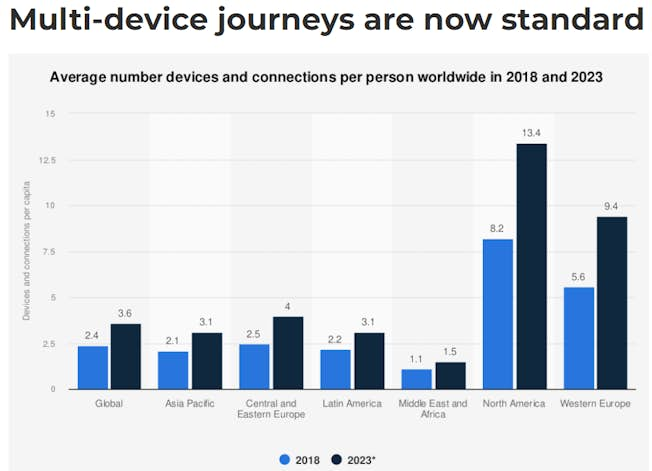
Major platforms like Meta (Facebook and Instagram) and Google do not proactively notify advertisers of overcharges or false clicks, requiring constant manual auditing to avoid wasting ad spend. This situation has made it necessary for many businesses to employ agencies, consultants, or dedicated team members to monitor and audit their advertising efforts regularly.
Key takeaways
- AdTech is less trackable, and less reliable than in years past. Make sure you’re building and testing your own models.
- Fraud, misleading attribution, and easy overspending mean it’s critical to regularly conduct ad audits, and manually file complaints with your ad providers.
- If you currently run ads that rely on third-party cookies (in other words, almost everything outside Apple’s ecosystem), prepare for a massive shakeup in the next year, probably including higher ad prices.
The rise of dark traffic
The rise of dark traffic, also known as dark social, is a significant trend affecting marketers’ ability to track and attribute website visits accurately. Many companies find that their marketing efforts often involve people hearing about them through podcasts, webinars, or social media posts. However, when these individuals eventually visit the company’s website, the traffic is typically attributed to direct visits or organic search, masking the true sources of influence.
For instance, SparkToro’s own analytics show that 76% of their visitors come from direct traffic and 13% from organic search, accounting for 90% of their total traffic. However, this data is misleading as it doesn’t reflect the actual sources that led users to search for or directly type in the company’s URL. In reality, much of this traffic likely originates from various platforms like WhatsApp, Slack, LinkedIn, Instagram, Facebook, TikTok, and Discord, where people discuss and share links to the company’s content.
An experiment conducted with Steve Lamar from Really Good Data revealed that many traffic sources are incorrectly marked as direct. For example, traffic from Slack communities, both private and public, is often misattributed because the referral string is removed. This issue is particularly prevalent in B2B contexts, where discussions and link sharing in private channels lead to website visits that cannot be accurately traced back to their origin. As a result, companies are unable to see and measure the impact of these important traffic sources.
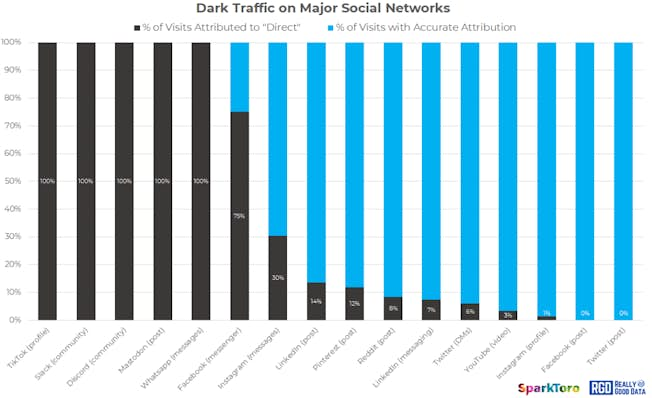
Key takeaways
- If you’ve moved away from social media investments because you can no longer see the referral traffic, you’re likely losing out to smarter teams who focus on reach and attribution.
- If you need to track search and social for your client or boss, it’s time to revisit so-called ‘vanity metrics’, because they’re the only things that can show you relative reach and engagement.
- Investing in sources that send indirect or un-attributable traffic doesn’t have to mean un-trackable! You can build time-series or geographic measurement systems to see the results of dark traffic channels.
The big lie of marketing attribution
To illustrate this problem, consider this story about a pizzeria owner in Milan who hired three teenagers to distribute flyers with discount codes. One teenager appeared highly successful, but it was later discovered he was simply handing out flyers to people already heading to the pizzeria. This anecdote parallels how companies like Google and Facebook might be taking credit for sales that would have happened anyway, using their vast data to target ads at people who were likely to make a purchase regardless.
Attribution modeling has always been flawed and is becoming increasingly unreliable due to factors such as privacy laws, the use of multiple devices and browsers, and the rise of dark traffic.
Despite claims from martech vendors about improved attribution through AI and machine learning, it’s impossible to build attribution models accurate enough to precisely credit all touchpoints in a customer’s journey, especially given the complexities of our modern digital landscape.
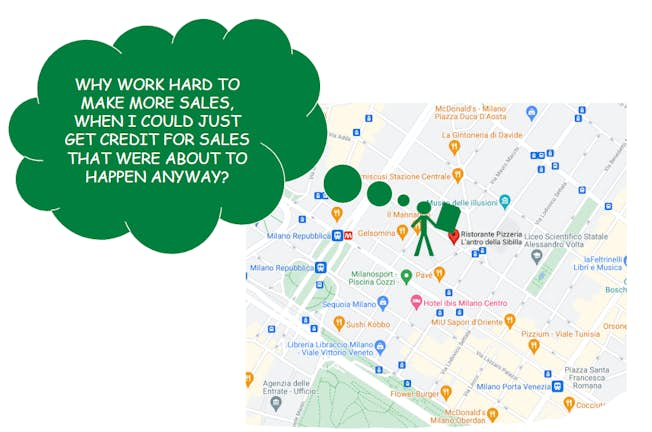
- Test turning off your ads
The end of the rising tide
For the last quarter century, we’ve seen every graph related to web usage, search engine usage, and internet users consistently trending upward. Even during economic downturns, like the 2009 financial crisis, we still saw more people online, using apps, and engaging in ecommerce activities compared to previous years. This trend of continuous growth has been a constant in the digital landscape.However, this era of consistent growth is coming to an end. We’re now seeing a plateau or even decline in traffic available from major sources like Google and Facebook. The growth rates are no longer what they used to be. For instance, Facebook’s daily active user growth and online media spend in the United States have been declining for some time.
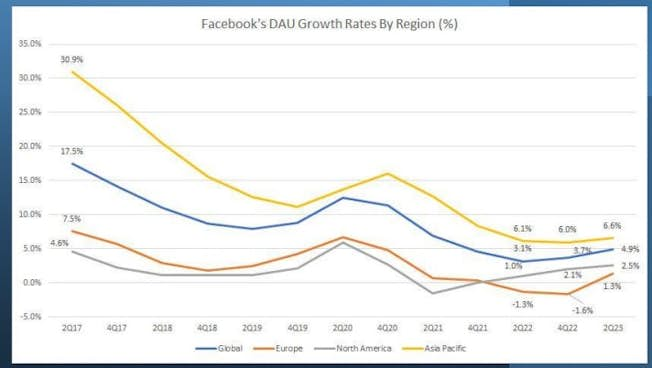
It’s a hard pill for a lot of people to swallow but hard-to-measure channels, investments like content marketing, social media, press and PR, media relations, small scale influencer marketing, podcasts, webinars, conferences and events - all of those things. They’re hard to measure.
But they're also the least competitive channels.
The easiest to measure channels, and the channels that give you the best attribution, like Facebook, Google, Apple, Amazon ad spend - those are the ones that everybody's already doing. And so they are the most competitive.
Key takeaways
- Talk to your C-Suite about the balance between growth vs. profitability. For a long time, marketers have been trained to invest in unprofitable growth to get share; now, that can backfire.
- Hard-to-measure channels are usually the least competitive, most affordable, most effective way to reach customers. It’s our job to educate leadership about how and why this works.
- No two companies should have the same marketing mix. If you’re copycatting competitors or investing in channels based on a standard template, there’s almost certainly room for improvement
Living in a zero-click world
Let’s now consider the phenomena of ‘zero-click content’ and ‘zero-click marketing’. Major platforms like Facebook, Twitter, LinkedIn, and Google are increasingly keeping users on their own sites rather than sending traffic to external websites. These platforms are prioritizing native content and even punishing content that contains outbound links. This trend is convenient for users but frustrating for publishers and content creators. Tests show that posts without links can receive up to 10 times more reach than those with links across various platforms.
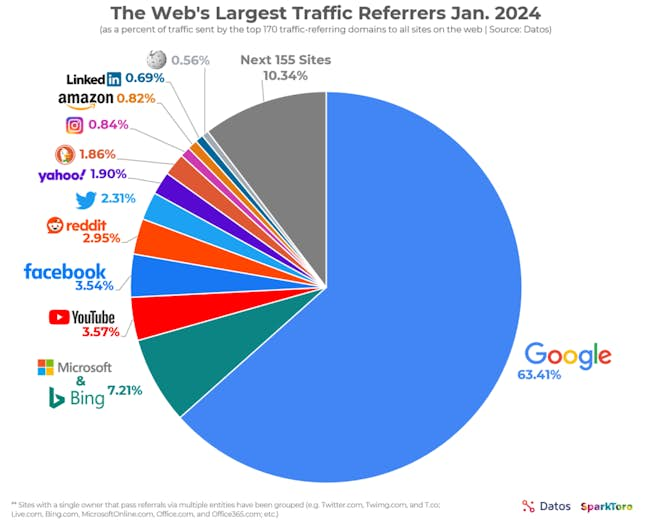
When examining referral traffic sources, we can see that Google dominates, sending about 63% of all referring traffic. Combined with Microsoft and Bing, search engines account for about 70% of all traffic referrals. However, nearly half of all referral traffic from these big sites goes to just the top 100–200 domains, leaving medium- and small-sized businesses with significantly less traffic than before.
Interestingly, referrals don’t tell the whole story of influence. While search accounts for 70% of referrals, it only represents about 10% of online attention. The majority of online time is spent on productivity tools, social media, video and audio platforms, games, and news sites. This discrepancy suggests that focusing solely on traffic sources may lead to an overemphasis on search, while neglecting other influential channels where people actually consume content and are influenced in their decisions.
Key takeaways
- Those who focus exclusively on traffic acquisition are stuck with search.
- Trying to prove acquisition via referral strings will make you Google’s fool.
- To win at social, you’ve got to embrace zero-click content.
- To determine platform prioritization, research where your audience engages.
Email: The last channel standing
While we’re seeing declines in effectiveness across various marketing channels like print, TV, social media platforms, and even search, there’s one platform that has remained consistently strong: email. When you track email open and clickthrough rates data going back to 2005, the results are remarkable. For nearly 20 years, email has maintained similar average open and clickthrough rates, defying the doom and gloom predictions about its demise.

Despite concerns that younger generations aren’t using email, the data suggests that once they enter the workforce, they engage with email at similar rates to other age groups.
While it’s fine to experiment with other channels like TikTok, the volatility of these platforms is concerning. For instance, X has become nearly useless in the current era. Facebook has drastically reduced organic reach, and other platforms face various challenges. Given email’s enduring value, consider acquiring valuable email lists through mergers and acquisitions or partnering with those who have built strong audiences through newsletters. Email sponsorships can also be an effective strategy in this landscape.
" Email is the best channel if you want to own your own audience and be able to influence them on a consistent basis. "- Rand Fishkin
Key takeaways
- Almost every marketing team should make email their primary channel of choice, nudging all non-sales conversions to those lists.
- Investments in other channels should come with risk assessments about their future. (Could the US or EU shut off TikTok access? Could X die entirely? Could Microsoft end linking out from LinkedIn?) Not carrying out these risk assessments is simply irresponsible.
- Acquisitions of web or media properties for their email lists are probably undervalued and may give significant leverage that the market hasn’t accurately priced-in.
Other channels to consider
Suppose you’re trying to reach an audience through Google and don’t have an established, high-ranking site. Consider using some of the alternative social media platforms.Using YouTube, Reddit, or another powerful domain in your niche while you build your site’s authority is the right way to go. Reddit is proving successful for organic listings, especially if you’re trying to reach graphic designers. (Other useful platforms for reaching this specialty include Pinterest, Behance, and LinkedIn.).
Threads
If X (Twitter) ever drove value for you or your marketing, it probably makes sense to adopt and start marketing on Threads. Early users still get outsized benefits through the ‘following’ recommendation engine.
|
Tranining Program

DMI PRO is the best training program in Digital Marketing
with DMI’s Global Standards in Digital Marketing Training. This program will transform Marketers into Global Digital Marketers, and develop a new generation of Marketers for the Digital Age.
For more information
|
RELATED ARTICLES
-
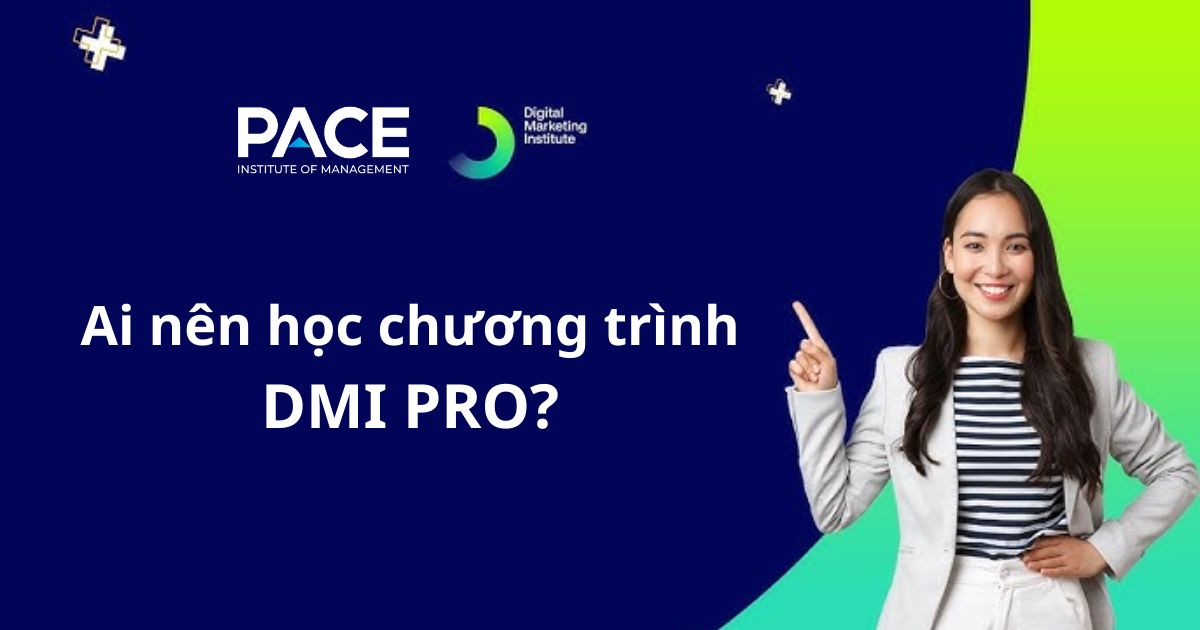 Ai nên học DMI PRO? Marketer, chủ doanh nghiệp hay người mới?
Ai nên học DMI PRO? Marketer, chủ doanh nghiệp hay người mới?
-
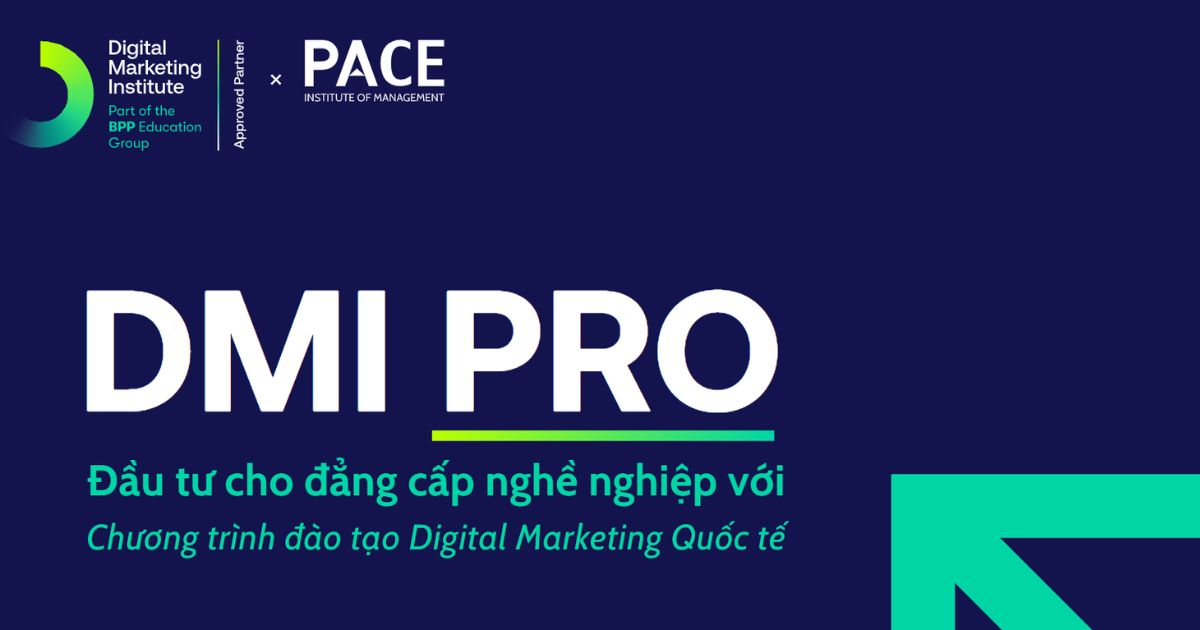 Điểm khác biệt nổi bật của chương trình DMI PRO
Điểm khác biệt nổi bật của chương trình DMI PRO
-
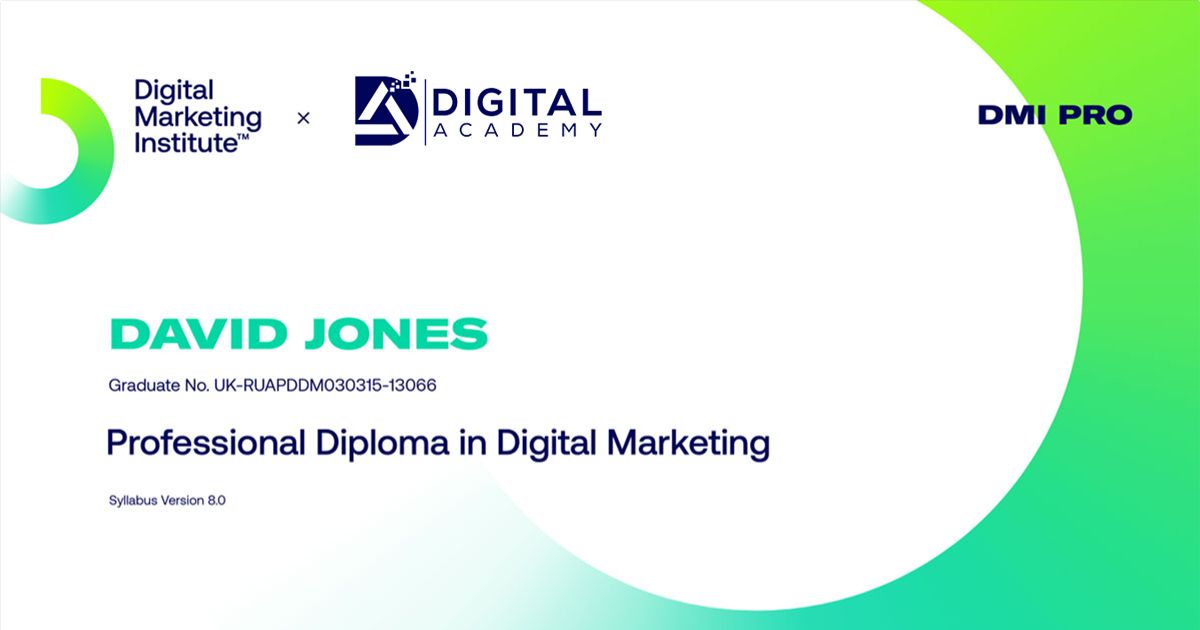 Vươn tầm thế giới với Chứng chỉ Digital Marketing Quốc tế
Vươn tầm thế giới với Chứng chỉ Digital Marketing Quốc tế
-
 Tổng hợp các công ty tư vấn chiến lược và quản trị doanh nghiệp ở Việt Nam
Tổng hợp các công ty tư vấn chiến lược và quản trị doanh nghiệp ở Việt Nam
-
 Danh sách các công ty đào tạo doanh nghiệp chất lượng tại Việt Nam
Danh sách các công ty đào tạo doanh nghiệp chất lượng tại Việt Nam
We will support the journey!

VIETNAMESE MARKETERS TO GAIN
THE DMI’S CDMA CERTIFIED & JOIN THE
GLOBAL DIGITAL MARKETERS COMMUNITY



